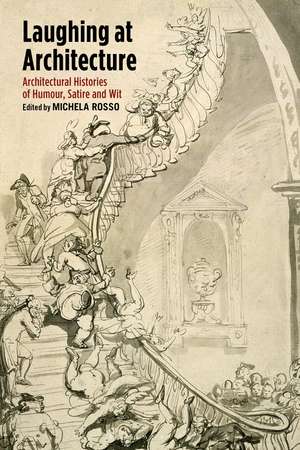Laughing at Architecture: Architectural Histories of Humour, Satire and Wit
Editat de Michela Rossoen Limba Engleză Paperback – 24 iun 2020
Preț: 225.49 lei
Preț vechi: 258.58 lei
-13% Nou
Puncte Express: 338
Preț estimativ în valută:
43.15€ • 46.86$ • 36.25£
43.15€ • 46.86$ • 36.25£
Carte tipărită la comandă
Livrare economică 22 aprilie-06 mai
Preluare comenzi: 021 569.72.76
Specificații
ISBN-13: 9781350170490
ISBN-10: 1350170496
Pagini: 288
Ilustrații: 73 bw illus
Dimensiuni: 156 x 234 x 21 mm
Greutate: 0.41 kg
Editura: Bloomsbury Publishing
Colecția Bloomsbury Visual Arts
Locul publicării:London, United Kingdom
ISBN-10: 1350170496
Pagini: 288
Ilustrații: 73 bw illus
Dimensiuni: 156 x 234 x 21 mm
Greutate: 0.41 kg
Editura: Bloomsbury Publishing
Colecția Bloomsbury Visual Arts
Locul publicării:London, United Kingdom
Caracteristici
Impressive scope: from Hogarth's parodies of 17th-century London to contemporary Chinese artworks mocking China's new 'iconic' architecture
Notă biografică
Michela Rosso is Associate Professor of Architecture at the Politechnico di Torino, Italy. In 2014 she was elected General Chair of the Advisory Board of the European Architectural History Network, and in 2016 she was awarded a residential fellowship at the Yale Center for British Art.
Cuprins
List of Figures List of Contributors Introduction, Michela Rosso 1. Laughing at the Baroque: A Drawing and Some Texts Compared, Susanna Pasquali 2. From Reportage to Ridicule: Satirizing the Building Industry in the Eighteenth-century Irish Press, Conor Lucey 3. The Thorn of Scorn: John Nash and his All Souls Church for a Transformed Regency London, Daniela Roberts 4. 'A Joke that has Gone on Far too Long': Mocking the Completion of the New Hôtel des Postes de Paris (1886-1888), Guy Lambert5. Deconstructing Gaudí: Intertwined Relationships between Satire and Architectural Criticism, Josep-Maria Garcia-Fuentes6. Confronting Problems with a Sense of Humour: Adolf Loos's Architectural Polemics and Viennese Journalism, Ruth Hanisch7. Words and Images of Contempt: Il Selvaggio on Architecture (1926-1942), Michela Rosso 8. Osbert Lancaster: Architectural Humour in the Time of Functionalism, Alan Powers9. Irrational Interiors: The Modern Domestic Landscape Seen in Caricatures, Gabriele Neri 10. From 'Little Russia' (Klein Rusland) to 'Planet of the Apes' (De Apenplaneet): Nicknaming Twentieth-century Mass Housing in Belgium, Evert Vandeweghe11. Saul Steinberg's Graph Paper Architecture: Humorous Drawings and Diagrams as Instruments of Critique, Christoph Lueder12. The Modern City Through the Mirror of Humour: A Different Portrait, Olivier Ratouis13. Splendid?! Preposterous! Chinese Artists Mock the Architectural Spectacle, Angela Becher Index
Recenzii
Satire opens the mind even as it leaves the mouth gaping... and it turns out to have been an inherent ingredient in the symbiotic rise of public debate and modernization since the mid-18th century. That is one of the many conclusions of this anthology of ribald images and erudite analyses that place humour in its social ad political context. The collection is as delightful as it is insightful, the humor runs the full gamut from affectionate to wickedly biting.
Although architecture is usually regarded as too ponderous a matter to allow much space for humour, some of its sharpest and most memorable criticism has been in the form of wit and satire. The essays in Laughing at Architecture, both diverting and serious, range from Pugin to Loos, to Steinberg, and open up this important, but neglected, mode of architectural criticism.
This pathbreaking collection of essays brilliantly links architecture to social history and to the multiple cultural contexts and interpersonal exchanges implicit in acts of ridicule and satiric irony. The section by Rosso herself, on the irrepressible, often volcanic, pasquinade of the 1930s Italian architectural scene launched by Mino Maccari and Leo Longanesi in the journal Il Selvaggio, is a true gem. Edited with an incisive critical introduction and beautifully produced with copious illustrations, this book will be a scholarly reference for years to come.
Although architecture is usually regarded as too ponderous a matter to allow much space for humour, some of its sharpest and most memorable criticism has been in the form of wit and satire. The essays in Laughing at Architecture, both diverting and serious, range from Pugin to Loos, to Steinberg, and open up this important, but neglected, mode of architectural criticism.
This pathbreaking collection of essays brilliantly links architecture to social history and to the multiple cultural contexts and interpersonal exchanges implicit in acts of ridicule and satiric irony. The section by Rosso herself, on the irrepressible, often volcanic, pasquinade of the 1930s Italian architectural scene launched by Mino Maccari and Leo Longanesi in the journal Il Selvaggio, is a true gem. Edited with an incisive critical introduction and beautifully produced with copious illustrations, this book will be a scholarly reference for years to come.
